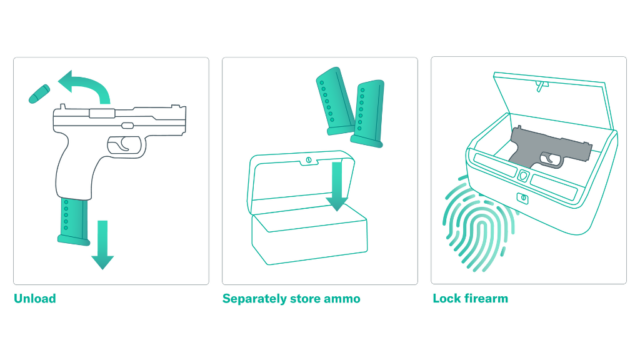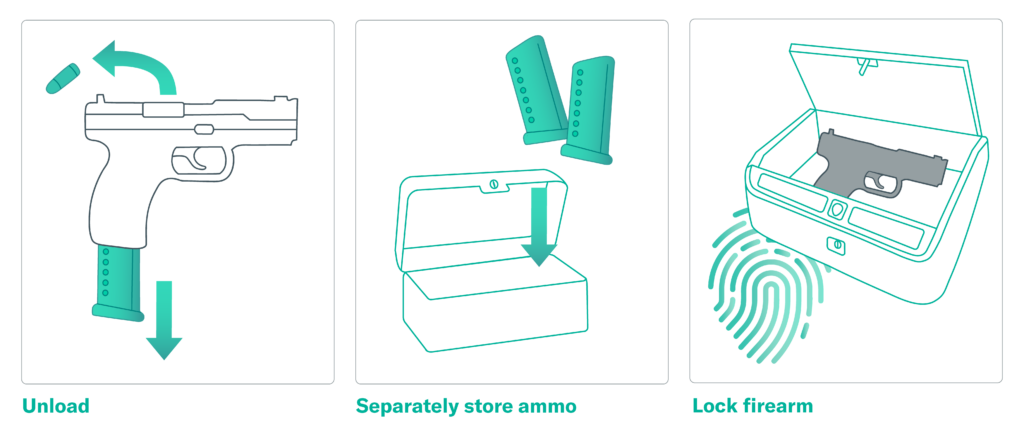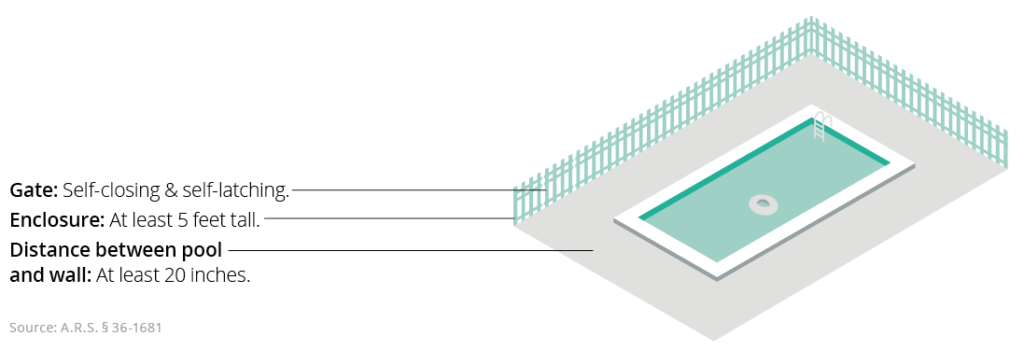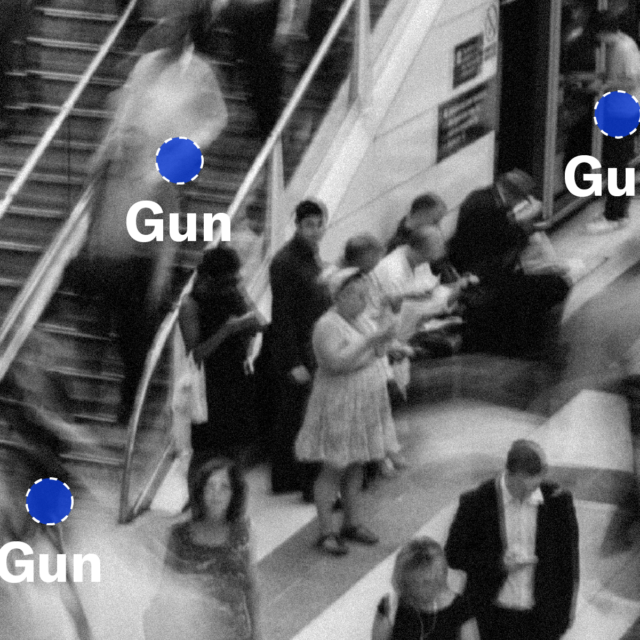Unload, Lock, and Separate
Secure Storage Practices to Reduce Gun Violence
Last Updated: 3.10.2025

Introduction
There are an estimated 393 million civilian-owned firearms in the United States,1Aaron Karp, “Estimating Global Civilian-Held Firearms Numbers,” (Small Arms Survey, June 2018), https://bit.ly/3snZ9fH. and roughly one-third of homes contain at least one gun.2General Social Survey, 2022, Data Explorer. https://bit.ly/2BZhtky; Heather McCracken, Haley Okuley, and Lee Floyd, “Gun Ownership in America,” RAND Corporation, 2020, https://www.rand.org/research/gun-policy/gun-ownership.html. Responsible gun owners can make our homes and communities safer by storing their firearms unloaded and locked, with ammunition kept in a separate place, to prevent access by children and other people who are at risk of harming themselves or others. Research shows that these storage practices can play a vital role in reducing the risk of gun violence, particularly among children, due to unintentional shootings and gun suicides.3Michael C. Monuteaux, Deborah Azrael, and Matthew Miller, “Association of Increased Safe Household Firearm Storage with Firearm Suicide and Unintentional Death Among US Youths,” JAMA Pediatrics 173, no. 7 (2019): 657–62, https://doi.org/10.1001/jamapediatrics.2019.1078
The bottom line is this: Storing firearms unloaded, locked, and separate from ammunition prevents access and saves lives.
Three-year-old Brayden Heath found his mother’s handgun in the living room of their home in Anchorage, Alaska. Brayden was playing with the gun when it discharged, shooting him in the head. He was taken to a local hospital and pronounced dead later that day.1“Judge sentences Morin to 18 months in jail for death of toddler in 2015,” KTUU, February 2, 2017, https://bit.ly/2Xqf1lr.
What is Secure Firearm Storage?
Experts agree: In order to prevent access, secure gun storage practices should include three methods employed in combination—unloading the ammunition, locking the firearm, and storing the firearm and ammunition in separate locations.2US Government Accountability Office, “Personal Firearms: Programs That Promote Safe Storage and Research on Their Effectiveness,” September 2017, https://bit.ly/394UGFP.

Unload
Gun owners should remove all ammunition from the firearm, including removing any chambered rounds
Lock
Unloaded firearms should be secured with a firearm locking device, such as a cable lock, or in a locked location, like a safe or lock box. Locking devices, safes, and lock boxes are equipped with keys, combinations, or biometric technology that limit access. Remember: Firearm locks do not prevent gun theft.
Separate
Ammunition should be stored separately from the firearm in a secure location.
The American Academy of Pediatrics (AAP) concludes that the absence of guns from homes is the most reliable and effective measure to prevent suicide, homicide, and unintentional firearm-related injuries to children and adolescents. But if there are guns in the home, AAP notes that storing guns unloaded and locked, with ammunition kept in a separate place, can mitigate the risk of child firearm injury.3Council on Injury, Violence, and Poison Prevention Executive Committee, “Firearm-related Injuries Affecting the Pediatric Population,” Pediatrics 130, no. 5 (2012): e1416–23, https://doi.org/10.1542/peds.2012-2481.
Key Findings
Access to unsecured firearms contributes to gun violence among children and teens. Brayden’s tragic story is all too common. Every year, nearly 360 children under the age of 18 unintentionally shoot themselves or someone else.4Everytown for Gun Safety Support Fund, “#NotAnAccident Index,” https://everytownresearch.org/maps/notanaccident/. Average: 2015–2024. Everytown tracks unintentional shootings by children that result in death or injury. Everytown researchers continually review media reports to identify shootings in which a person age 17 or under unintentionally fires a gun and harms themselves or someone else. For each identified incident, the researchers review available public records and, when necessary, follow up with local law enforcement to ascertain details about the incident, including location, type of firearm, and method of storage. That’s roughly one unintentional shooting per day, and more than 70 percent of these incidents take place in or around a home.5Everytown for Gun Safety Support Fund, “Preventable Tragedies: Unintentional Shootings by Children,” April 26, 2023, https://everytownresearch.org/report/notanaccident/. More than 700 children die by gun suicide each year,6Centers for Disease Control and Prevention, National Center for Health Statistics. WONDER Online Database, Underlying Cause of Death. Average: 2019–2023. Ages: 0–17. most often using guns belonging to a family member.7Catherine Barber et al., “Who Owned the Gun in Firearm Suicides of Men, Women, and Youth in Five US States?” Preventive Medicine 164 (2022): 107066, https://doi.org/10.1016/j.ypmed.2022.107066; Namkee G. Choi, Diana M. DiNitto, and C. Nathan Marti, “Youth Firearm Suicide: Precipitating/Risk Factors and Gun Access,” Children and Youth Services Review 83 (December 2017): 9–16, https://doi.org/10.1016/j.childyouth.2017.10.022; Renee M. Johnson et al., “Who Are the Owners of Firearms Used in Adolescent Suicides?,” Suicide & Life-Threatening Behavior 40, no. 6 (2010): 609–11, https://doi.org/10.1521/suli.2010.40.6.609. Unsecured firearms also fuel gun violence outside the home. The US Secret Service found that three-quarters of school shooters acquired their firearm from the home of a parent or close relative.8National Threat Assessment Center, “Protecting America’s Schools: A US Secret Service Analysis of Targeted School Violence,” US Secret Service, Department of Homeland Security, 2019, https://bit.ly/2U7vnwa.
We are all safer when guns are stored unloaded, locked, and separate from ammunition. One study found that households that locked both firearms and ammunition were associated with a 78 percent lower risk of self-inflicted firearm injuries and an 85 percent lower risk of unintentional firearm injuries among children, compared to those that locked neither.9David C. Grossman et al., “Gun Storage Practices and Risk of Youth Suicide and Unintentional Firearm Injuries,” JAMA 293, no. 6 (2005): 707–14, https://doi.org/10.1001/jama.293.6.707. Another study estimated that if half of households with children that contain at least one unlocked gun switched to locking all their guns, one-third of youth gun suicides and unintentional deaths could be prevented, saving an estimated 251 lives in a single year.10Monuteaux, Azrael, and Miller, “Safe Household Firearm Storage.”
Despite the risks to safety, the majority of gun owners do not practice secure gun storage. While millions of responsible gun owners follow recommended storage practices, an estimated 58 percent do not lock all of their guns, let alone store them unloaded, locked, and separate from ammunition.11Michael D. Anestis et al., “Assessment of Firearm Storage Practices in the US, 2022,” JAMA Network Open 6, no. 3 (2023): e231447, https://doi.org/10.1001/jamanetworkopen.2023.1447. Gun owners with children in the home are slightly more likely to lock all of their guns,12Cassandra K. Crifasi et al., “Storage Practices of US Gun Owners in 2016,” American Journal of Public Health 108, no. 4 (2018): 532–37, https://doi.org/10.2105/AJPH.2017.304262. but an estimated 4.6 million American children live in households with at least one unlocked and loaded firearm.13Matthew Miller and Deborah Azrael, “Firearm Storage in US Households with Children: Findings from the 2021 National Firearm Survey,” JAMA Network Open 5, no. 2 (2022): e2148823, https://doi.org/10.1001/jamanetworkopen.2021.48823.
1/3
One-third of youth suicides and unintentional deaths could be prevented by securing guns.
Michael C. Monuteaux et al., “Association of Increased Safe Household Firearm Storage with Firearm Suicide and Unintentional Death Among US Youths,” JAMA Pediatrics 173, no. 7 (2019): 657–62, https://doi.org/10.1001/jamapediatrics.2019.1078.
Contrary to popular belief, gun storage devices do not prevent owners from readily accessing their guns. There is a common myth that storage devices negate the self-defense purpose of owning a gun by putting time-consuming barriers between the gun owner and their means of defense.14John R. Lott, Jr. and John E. Whitley, “Safe‐Storage Gun Laws: Accidental Deaths, Suicides, and Crime,” Journal of Law and Economics 44, no. 52 (October 2001), https://doi.org/10.1086/338346. The reality is that there are many affordable options for secure gun storage that provide owners with access to guns in a matter of seconds while still preventing access by children and people at increased risk of harming themselves or others. Further, it is possible that unsecured guns may actually increase the likelihood of crime and violence through an increased risk of gun theft.15Jay Szkola, Megan J. O’Toole, and Sarah Burd-Sharps, “Gun Thefts from Cars: The Largest Source of Stolen Guns,” Everytown for Gun Safety Support Fund, May 9, 2024, https://everytownresearch.org/report/gun-thefts-from-cars-the-largest-source-of-stolen-guns-2. Each year, more than 200,000 guns are stolen16ATF, “National Firearms Commerce and Trafficking Assessment (NFTCA), Volume II: Crime Gun Intelligence and Analysis—Part V: Firearm Thefts,” January 2023, https://www.atf.gov/firearms/docs/report/nfcta-volume-ii-part-v-firearm-thefts/download. According to the ATF, there were 1,026,538 guns reported stolen to the FBI NCIC between 2017 and 2021. To account for guns stolen from citizens but not reported, this number was multiplied by 1.25 to estimate 1,283,173 total guns stolen from private citizens during that period. This total was then divided by 5 (years) to produce an estimate of 256,635 guns stolen from private gun owners per year between 2017 and 2021.—the majority from cars—and many are funneled into the underground market, where once-legally-owned firearms can be transferred to people with dangerous histories.17Philip J. Cook, “Gun Markets,” Annual Review of Criminology 1 (2018): 359–77, https://doi.org/10.1146/annurev-criminol-032317-092149; ATF, “National Firearms Commerce and Trafficking Assessment (NFTCA), Volume II: Crime Gun Intelligence and Analysis—Part V: Firearm Thefts,” January 2023, https://www.atf.gov/firearms/docs/report/nfcta-volume-ii-part-v-firearm-thefts/download.
Why Do Safety Regulations for Pool Owners Far Exceed Those for Gun Owners?
American children are three times more likely to be shot and killed than they are to die by drowning.18Centers for Disease Control and Prevention, National Center for Health Statistics. WONDER Online Database, Underlying Cause of Death. Data from 2023. Ages: 1–17. Deaths by drowning include deaths that occur in other bodies of water in addition to pools. Yet safety regulations for pools are far more pervasive and restrictive than those for guns.
The majority of states require that private pool owners use fences or locked gates to prevent drownings or other accidents.19These regulations vary by state and include both building codes and state statutes. Many states have laws mandating that gun owners store their firearms securely.
Firearms are the leading cause of death for children 1-17 in the US.
Last updated: 3.10.2025
Regulations for Pool Owners in Arizona
In Arizona, for example, pool owners must adhere to safety regulations regarding barriers and gates to prevent access. There are no safety regulations for gun owners in Arizona.

Current Policy and Program Landscape
Various laws and public awareness programs are in place throughout the country to promote secure gun storage and provide incentives for gun owners to follow recommended storage practices.
Federal Policy
There is no federal law requiring secure storage by gun owners. Federal law requires gun dealers to provide a secure gun storage or gun safety device with the sale of every handgun.2018 USC. § 922(z)(1); 18 USC. § 921(a)(34). A “secure gun storage or safety device” is defined as: (A) a device that, when installed on a firearm, is designed to prevent the firearm from being operated without first deactivating the device; (B) a device incorporated into the design of the firearm that is designed to prevent the operation of the firearm by anyone not having access to the device; or (C) a safe, gun safe, gun case, lock box, or other device that is designed to be or can be used to store a firearm and that is designed to be unlocked only by means of a key, a combination, or other similar means. However, the law does not require that gun owners actually use the device—or any other best practices—to secure their firearms.
State- & Local-Level Policies
State-level laws regarding firearm storage vary widely. The strongest state laws mandate that gun owners secure firearms when they are not in the owner’s possession. Other laws further encourage people to secure their firearms in order to keep them out of the hands of children or persons legally prohibited from having them.
Some states have passed a form of secure gun storage laws, known as child access prevention (CAP) laws. These laws vary by state but generally stipulate that if a minor accesses a firearm, the person who failed to adequately secure the firearm is liable.
Which states have child-access and/or secure storage laws?
26 states have adopted this policy
Secure Storage or Child Access Prevention Required
Alabama has not adopted this policy
Secure Storage or Child Access Prevention Required
Alaska has not adopted this policy
Secure Storage or Child Access Prevention Required
Arizona has not adopted this policy
Secure Storage or Child Access Prevention Required
Arkansas has not adopted this policy
Secure Storage or Child Access Prevention Required
California has adopted this policy
- When does the law apply?
- Any time not in owner’s immediate control
- How does the state define child?
- Under 18
- Does the state law require storage to prevent access by other prohibited people?
- Yes
Secure Storage or Child Access Prevention Required
Colorado has adopted this policy
- When does the law apply?
- When child may or is likely to access
- How does the state define child?
- Under 18
- Does the state law require storage to prevent access by other prohibited people?
- Yes
Secure Storage or Child Access Prevention Required
Connecticut has adopted this policy
- When does the law apply?
- Any time not in owner’s immediate control
- How does the state define child?
- Under 18
- Does the state law require storage to prevent access by other prohibited people?
- Yes
Secure Storage or Child Access Prevention Required
Delaware has adopted this policy
- When does the law apply?
- After child gains access
- How does the state define child?
- Under 18
- Does the state law require storage to prevent access by other prohibited people?
- Yes
Secure Storage or Child Access Prevention Required
Florida has adopted this policy
- When does the law apply?
- After child gains access
- How does the state define child?
- Under 16
- Does the state law require storage to prevent access by other prohibited people?
- No
Secure Storage or Child Access Prevention Required
Georgia has not adopted this policy
Secure Storage or Child Access Prevention Required
Hawaii has adopted this policy
- When does the law apply?
- After child gains access
- How does the state define child?
- Under 18
- Does the state law require storage to prevent access by other prohibited people?
- No
Secure Storage or Child Access Prevention Required
Idaho has not adopted this policy
Secure Storage or Child Access Prevention Required
Illinois has adopted this policy
- When does the law apply?
- After child gains access
- How does the state define child?
- Under 14
- Does the state law require storage to prevent access by other prohibited people?
- No
Secure Storage or Child Access Prevention Required
Indiana has not adopted this policy
Secure Storage or Child Access Prevention Required
Iowa has adopted this policy
- When does the law apply?
- After child gains access
- How does the state define child?
- Under 14
- Does the state law require storage to prevent access by other prohibited people?
- No
Secure Storage or Child Access Prevention Required
Kansas has not adopted this policy
Secure Storage or Child Access Prevention Required
Kentucky has not adopted this policy
Secure Storage or Child Access Prevention Required
Louisiana has not adopted this policy
Secure Storage or Child Access Prevention Required
Maine has adopted this policy
- When does the law apply?
- After child gains access
- How does the state define child?
- Under 16
- Does the state law require storage to prevent access by other prohibited people?
- No
Secure Storage or Child Access Prevention Required
Maryland has adopted this policy
- When does the law apply?
- When child may or is likely to access
- How does the state define child?
- Under 18
- Does the state law require storage to prevent access by other prohibited people?
- No
Secure Storage or Child Access Prevention Required
Massachusetts has adopted this policy
- When does the law apply?
- Any time not in owner’s immediate control
- How does the state define child?
- Under 18
- Does the state law require storage to prevent access by other prohibited people?
- No
Secure Storage or Child Access Prevention Required
Michigan has adopted this policy
- When does the law apply?
- After child gains access
- How does the state define child?
- Under 18
- Does the state law require storage to prevent access by other prohibited people?
- No
Secure Storage or Child Access Prevention Required
Minnesota has adopted this policy
- When does the law apply?
- When child may or is likely to access
- How does the state define child?
- Under 18
- Does the state law require storage to prevent access by other prohibited people?
- No
Secure Storage or Child Access Prevention Required
Mississippi has not adopted this policy
Secure Storage or Child Access Prevention Required
Missouri has not adopted this policy
Secure Storage or Child Access Prevention Required
Montana has not adopted this policy
Secure Storage or Child Access Prevention Required
Nebraska has not adopted this policy
Secure Storage or Child Access Prevention Required
Nevada has adopted this policy
- When does the law apply?
- When child may or is likely to access
- How does the state define child?
- Under 18
- Does the state law require storage to prevent access by other prohibited people?
- No
Secure Storage or Child Access Prevention Required
New Hampshire has adopted this policy
- When does the law apply?
- After child gains access
- How does the state define child?
- Under 16
- Does the state law require storage to prevent access by other prohibited people?
- No
Secure Storage or Child Access Prevention Required
New Jersey has adopted this policy
- When does the law apply?
- After child gains access
- How does the state define child?
- Under 16
- Does the state law require storage to prevent access by other prohibited people?
- No
Secure Storage or Child Access Prevention Required
New Mexico has adopted this policy
- When does the law apply?
- After child gains access
- How does the state define child?
- Under 18
- Does the state law require storage to prevent access by other prohibited people?
- No
Secure Storage or Child Access Prevention Required
New York has adopted this policy
- When does the law apply?
- When child may or is likely to access
- How does the state define child?
- Under 16
- Does the state law require storage to prevent access by other prohibited people?
- Yes
Secure Storage or Child Access Prevention Required
North Carolina has adopted this policy
- When does the law apply?
- After child gains access
- How does the state define child?
- Under 18
- Does the state law require storage to prevent access by other prohibited people?
- No
Secure Storage or Child Access Prevention Required
North Dakota has not adopted this policy
Secure Storage or Child Access Prevention Required
Ohio has not adopted this policy
Secure Storage or Child Access Prevention Required
Oklahoma has not adopted this policy
Secure Storage or Child Access Prevention Required
Oregon has adopted this policy
- When does the law apply?
- Any time not in owner’s immediate control
- How does the state define child?
- Under 18
- Does the state law require storage to prevent access by other prohibited people?
- No
Secure Storage or Child Access Prevention Required
Pennsylvania has not adopted this policy
Secure Storage or Child Access Prevention Required
Rhode Island has adopted this policy
- When does the law apply?
- Any time not in owner’s immediate control
- How does the state define child?
- Under 18
- Does the state law require storage to prevent access by other prohibited people?
- Yes
Secure Storage or Child Access Prevention Required
South Carolina has not adopted this policy
Secure Storage or Child Access Prevention Required
South Dakota has not adopted this policy
Secure Storage or Child Access Prevention Required
Tennessee has not adopted this policy
Secure Storage or Child Access Prevention Required
Texas has adopted this policy
- When does the law apply?
- After child gains access
- How does the state define child?
- Under 17
- Does the state law require storage to prevent access by other prohibited people?
- No
Secure Storage or Child Access Prevention Required
Utah has not adopted this policy
Secure Storage or Child Access Prevention Required
Vermont has adopted this policy
- When does the law apply?
- After child gains access
- How does the state define child?
- Under 18
- Does the state law require storage to prevent access by other prohibited people?
- Yes
Secure Storage or Child Access Prevention Required
Virginia has adopted this policy
- When does the law apply?
- When child may or is likely to access
- How does the state define child?
- Under 14
- Does the state law require storage to prevent access by other prohibited people?
- No
Secure Storage or Child Access Prevention Required
Washington has adopted this policy
- When does the law apply?
- After child gains access
- How does the state define child?
- Under 18
- Does the state law require storage to prevent access by other prohibited people?
- Yes
Secure Storage or Child Access Prevention Required
West Virginia has not adopted this policy
Secure Storage or Child Access Prevention Required
Wisconsin has adopted this policy
- When does the law apply?
- After child gains access
- How does the state define child?
- Under 14
- Does the state law require storage to prevent access by other prohibited people?
- No
Secure Storage or Child Access Prevention Required
Wyoming has not adopted this policy
8%
States with CAP laws saw an 8 percent decrease in overall suicide rates, and an 11 percent decrease in firearm suicide rates, among adolescents aged 14 to 17.
Webster DW, Vernick JS, Zeoli AM, Manganello JA. “Association Between Youth-Focused Firearm Laws and Youth Suicides”. JAMA. (2004). https://doi.org/10.1001/jama.292.5.594
In addition, several cities, including New York City and San Francisco, have local firearm storage ordinances requiring gun owners to secure their firearms when they are not in their possession.21New York City Administrative Code 10-312; San Francisco Police Code 4512.
Public Awareness and Community Actions
Across the country, lawmakers, community members, and local leaders are working together to promote public awareness campaigns about gun storage—such as Everytown for Gun Safety Support Fund’s Be SMART program—that encourage secure gun storage practices and highlight the public safety risks of unsecured guns and the role of guns in suicide.22For more information on Be SMART, see: besmartforkids.org/.
The Utah Suicide Prevention Coalition and the Utah Shooting Sports Council recognized their shared interest in preventing firearm suicide in their state and joined together to raise awareness.23Utah Suicide Prevention Coalition. Firearms Safety—Teen Suicide. https://bit.ly/2JEdBsl. To deliver their message directly to gun owners, they incorporated a public service announcement about guns and suicide into mandatory training sessions for concealed-carry permits.24Catherine Barber, “Pushing on an Open Door: Gun Owners Groups & Suicide Prevention,” (Harvard School of Public Health, 2017) https://bit.ly/2KjUQyE.
In New Hampshire, a coalition of researchers, gun owners, and gun dealers worked together to increase awareness of firearm suicide at a unique intervention point: when the individual enters the gun shop. Known as the Gun Shop Project, this campaign provided educational materials, including posters, brochures, and cards, to all the gun shops in the state.25Harvard T.H. Chan School of Public Health, “Gun Shop Project,” https://bit.ly/2c4QKah. The project has now been adopted in 11 states.26Harvard T.H. Chan School of Public Health, “Gun Shop Project.
Since 2019, school districts across the country have passed resolutions to require that information be sent home with students to educate parents about the importance of securely storing any firearms they own.27Students Demand Action for Gun Sense in America, “Urge Your School Board to Act on School Safety,” January 26, 2022, https://studentsdemandaction.org/report/urge-your-school-board-to-act-on-school-safety/. In some school districts, parents or guardians are required to sign and return a letter acknowledging that they have read the information. More than 10 million students in the US attend schools with these policies.28Everytown for Gun Safety, “As Kids Head Back to School Nationwide, What to Know about Keeping Communities Safe From Gun Violence This Upcoming School Year,” press release, August 25, 2023, https://www.everytown.org/press/as-kids-head-back-to-school-nationwide-what-to-know-about-keeping-communities-safe-from-gun-violence-this-upcoming-school-year/; Everytown for Gun Safety, “More Than 8.5 Million Students Nationwide Will Attend Schools With Secure Firearm Storage Policies During Next School Year Following Passage of Orange County, Florida Resolution,“ press release, December 15, 2022, https://www.everytown.org/press/more-than-8-5-million-students-nationwide-will-attend-schools-with-secure-firearm-storage-policies-during-next-school-year-following-passage-of-orange-county-florida-resolution/.
Recommendations
Gun owners understand that with rights comes responsibility, and promoting secure firearm storage is integral to public safety. Lawmakers and community members should work together to encourage recommended firearm storage practices through a combination of requirements and incentives for gun owners.
Federal law should be expanded to include a firearm storage law. States—and where permissible, cities—should enact new firearm storage laws and strengthen existing ones. These laws are demonstrably effective at increasing secure firearm storage and decreasing gun deaths.
Community members and local leaders should encourage secure gun storage through outreach to gun owners and general public awareness campaigns. Researchers, clinicians, educators, and gun owners should work together to develop messaging and recommend storage options that are relevant to local values and context.29Catherine Barber et al., “Suicide and Firearm Injury in Utah: Linking Data to Save Lives” (Harvard T.H. Chan School of Public Health, October 2018), https://bit.ly/2HP2kG3.
Research suggests that clinicians can positively influence secure storage practices, especially when they provide free storage devices.30RAND Corporation, “Education Campaigns and Clinical Interventions for Promoting Safe Storage,” March 2018, https://bit.ly/2KPD71h.
Learn More:
Everytown Research & Policy is a program of Everytown for Gun Safety Support Fund, an independent, non-partisan organization dedicated to understanding and reducing gun violence. Everytown Research & Policy works to do so by conducting methodologically rigorous research, supporting evidence-based policies, and communicating this knowledge to the American public.



